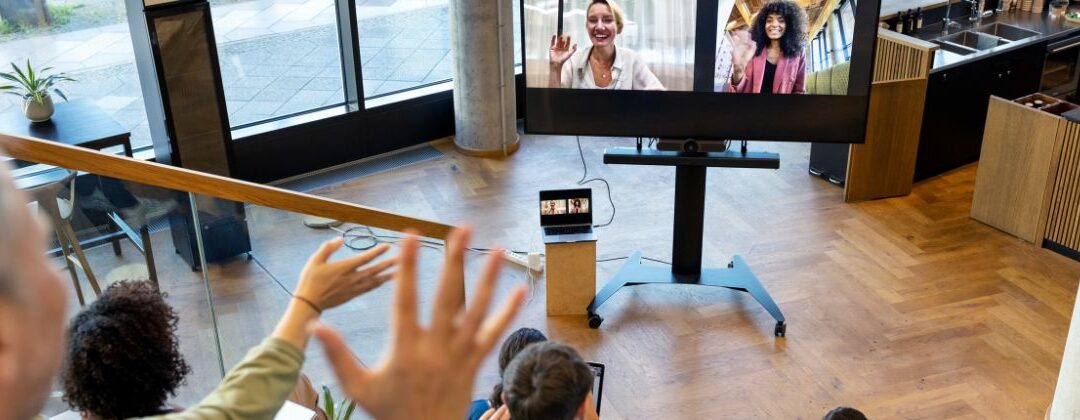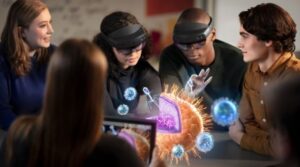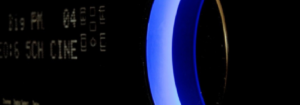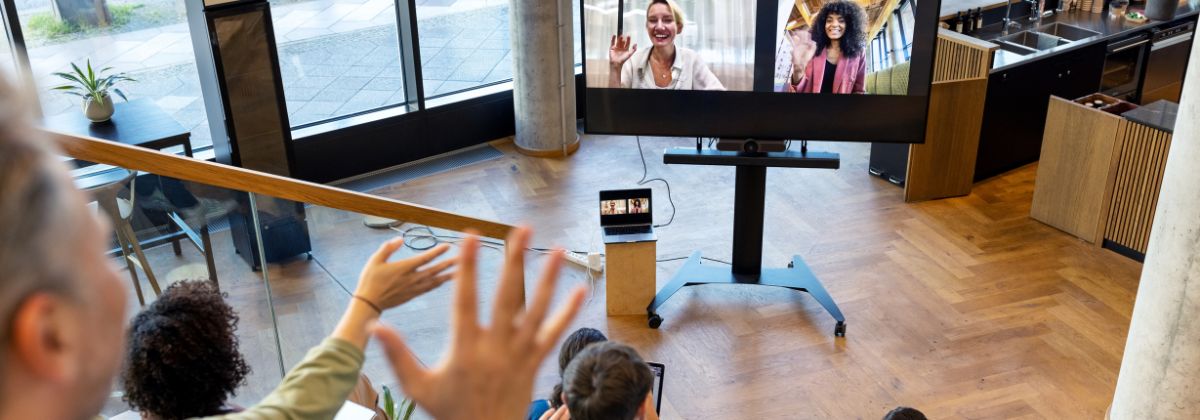
Setting up a Modern Classroom
In recent years and especially during the pandemic, the education landscape has witnessed a significant shift towards remote and hybrid classrooms.
The integration of technology and traditional teaching methods has paved the way for the emergence of hybrid classrooms, which gained immense popularity due to their ability to adapt to the changing needs of students and educators.
Here is how you can set up a modern classroom using innovative technology to create an integrated lesson experience and facilitate distance learning.
What is Hybrid Learning Model?
Hybrid learning is a blended learning approach that combines face-to-face instruction with online components, allowing students to engage in learning activities both inside and outside the physical classroom. Hybrid learning aims to leverage the benefits of both physical and virtual learning environments, providing learners with a more flexible and interactive educational experience.
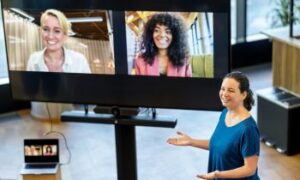 In a hybrid classroom, students attend some of their classes in person while also engaging in online assignments. The online components can include virtual lectures, multimedia resources, interactive simulations, discussion forums, and collaborative projects through various digital platforms.
In a hybrid classroom, students attend some of their classes in person while also engaging in online assignments. The online components can include virtual lectures, multimedia resources, interactive simulations, discussion forums, and collaborative projects through various digital platforms.
The specific implementation of a hybrid classroom can vary depending on the educational institution and the course requirements. Some hybrid courses will require a majority of in-person sessions with minimal online classes, while others might strike a balance between online and face-to-face activities.
That said, the goal is always to create a learning environment that maximises the benefits of both traditional and online education, catering to the diverse needs and preferences of students.
Benefits of Hybrid Learning
The hybrid learning model offers numerous benefits for both students and teachers.
For students, it provides the advantage of flexibility by allowing access to course materials and resources online. This empowers them to learn at their own pace, review content as needed, and cater to different learning styles. Moreover, the virtual nature of the hybrid classroom fosters interactive and collaborative activities through online discussions and forums, promoting a strong sense of community and inclusivity.
Teachers also benefit from this approach as they can leverage technology to deliver engaging lectures using multimedia elements like videos and interactive presentations. Additionally, online platforms provide tools for tracking student progress, enabling teachers to assess performance and offer targeted feedback and support.
Overall, hybrid classrooms enrich the learning experience, making it more dynamic and accessible for everyone involved.
Hybrid Classroom Setup
 Creating an optimal hybrid classroom setup is crucial for a seamless learning experience. You should carefully assess your needs before choosing the best fit for your modern teaching space. In order to make an informed decision, you must consider the following:
Creating an optimal hybrid classroom setup is crucial for a seamless learning experience. You should carefully assess your needs before choosing the best fit for your modern teaching space. In order to make an informed decision, you must consider the following:
- Reliable Technology: Make sure you have access to reliable internet connectivity, suitable devices, and necessary software to facilitate smooth online interactions.
- Comfortable Physical Space: Design a welcoming physical environment with comfortable seating, proper lighting, and appropriate acoustics to enhance in-person learning experiences.
- Interactive Displays: Use interactive displays, projectors, and smart boards to offer engaging presentations and interactive learning activities that will capture students’ attention.
- Collaboration Tools: Incorporate digital collaboration tools such as video conferencing platforms, virtual whiteboards, and shared document editors to make collaboration among students more accessible.
Examples of Hybrid Classroom Technology
Hybrid learning technology aims to create a cohesive and inclusive learning environment that maximises the benefits of both in-person and online learning modalities. It enables students to access educational resources from anywhere, fosters collaboration, and supports various learning styles.
- Video Conferencing Solutions: Platforms like Zoom, Microsoft Teams, or Google Classroom enable remote students to participate in real-time class discussions, lectures, and group activities alongside their in-person peers.
- Learning Management System (LMS): LMS platforms like Moodle, Canvas, or Blackboard provide a centralised online space for teachers to share resources, assignments, quizzes, and grades with both in-person and remote students.
- Interactive Whiteboards: Interactive whiteboards in physical classrooms allow teachers to display and annotate content, which can be simultaneously accessed by remote students through screen-sharing or video conferencing.
- Virtual Reality (VR) and Augmented Reality (AR): These technologies enable students to experience virtual field trips, simulations, or interactive learning activities, enriching their learning experience regardless of their physical location.
- Webcams and Microphones: Equipping classrooms with high-quality webcams and microphones ensures better audio-visual clarity for remote students and encourages active participation.
- Lecture Capture Solutions: A technology that can record (or “capture”) lecture content and make it available in a digital format to remote students or those who can’t be present in the classroom. This helps improve the inclusive learning experience significantly.
- Digital Collaboration Tools: Platforms like Google Workspace (formerly G Suite), Microsoft 365, or collaborative whiteboarding tools facilitate real-time collaboration and document sharing among students and teachers.
- Synchronous and Asynchronous Learning: By combining live online sessions with pre-recorded video lectures or materials, hybrid classrooms offer flexibility and accommodate different learning preferences.
Leveraging Hybrid Learning Technology
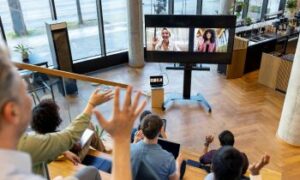 Students are used to having information at their fingertips, and if universities want to appeal to this new digital generation, they simply need to adapt to the demand. Not only will embracing AV technology drive student recruitment, but there are also many educational benefits for the students. Here are some of the main ones:
Students are used to having information at their fingertips, and if universities want to appeal to this new digital generation, they simply need to adapt to the demand. Not only will embracing AV technology drive student recruitment, but there are also many educational benefits for the students. Here are some of the main ones:
Improve learning through interaction and visualisation
Not only can LCD display screens show students important educational videos, which are easier to remember than text, but they can also be used to display graphs, charts and diagrams. These are good for openly encouraging discussions in class which have been shown to improve students’ understanding of the topics being discussed.
Additionally, with a good AV solution in place, students who benefit more from visual or interactive styles of learning can benefit just as much as those who prefer only to listen. In turn, this prevents them from becoming bored and disengaged.
Provide better audio
Poor sound quality is often cited as a challenge to overcome, particularly within large lecture theatres with hundreds of students.
By installing a good AV sound system with professionally amplified sound, universities can ensure that students spend less time struggling to hear what the teacher or lecturer is saying and more time absorbing and learning.
Enhance student collaboration
Rather than professors and students engaging in a ‘one-way broadcast’ style of teaching, learning is now expected to be a collaborative exercise.
With AV technology, students are encouraged to work together using technology such as interactive whiteboards, tablets, and wireless device casting, which can be controlled wirelessly by the lecturer. This helps students remain focused and engaged while allowing the lecturer to see if they understand what is being taught.
Encourage students with learning disabilities
Usually, students with disabilities require a more intimate teaching approach; however, this can be difficult to achieve in a lecture theatre with hundreds of other people. AV can provide a number of solutions to these problems.
For instance, students with dyslexia who may struggle with textbooks can benefit from interactive whiteboards that contain coloured text, video, and images as it makes the information easier to read or decode. Besides, an interactive whiteboard with an integrated audio system can boost a lecturer’s voice, making it easier for students with hearing impairments to follow along.
Enable a smooth and integrated classroom experience
 Hybrid learning technology can significantly enhance the learning experience for both in-person and remote students.
Hybrid learning technology can significantly enhance the learning experience for both in-person and remote students.
Through video conferencing, interactive displays, and screen-sharing functionalities, lecturers or teachers can connect with remote or virtual students, ensuring they receive the same level of instruction as their fellow students in the physical classroom.
Lesson delivery can also be improved as proper education AV solutions enable teachers to present intricate details of objects, documents, or experiments, facilitating better comprehension and retention, particularly for visual learners.
This ultimately fosters interactive learning, promoting student engagement and collaboration on projects, allowing for shared content annotation and valuable discussions, thus building teamwork and confidence in seeking guidance.
Prepare students for life after graduation
A recent IBM study revealed the primary skills students need to learn to succeed in the workplace. Among them are analysis and problem-solving, collaboration, teamwork, and adaptability.
As AV encourages a learning style that uses many of these skills, by incorporating its use into their study programmes, universities are ensuring that their students are fully prepared for life after graduation.
Additionally, with technology tools playing a part in a large number of workplaces, when students graduate, they will fit right into an environment with both skills and equipment that they have already been exposed to.
Install AV Technology Across Your Campus
Hybrid classrooms combine the best of both in-person and online learning, providing a flexible and dynamic educational environment.
Educators can create inclusive and effective hybrid classes by leveraging innovative AV and tech tools.
Using technology in the education sector is no longer just an option, it is a necessity. Over the years, we have worked with a number of higher education institutions to design and install a range of AV solutions to suit their range of needs and budgets.
Contact us today and find out how we can help implement blended learning in your classroom!

